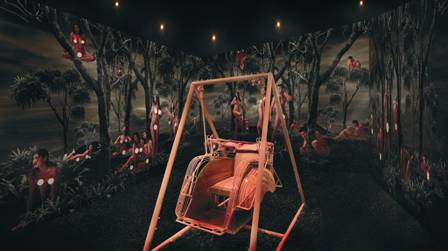<< Featured Works List
Pinkswing Park
2005
554 x 539 x 360 cm
Installation
(becak modification, digital print, black pebbles)

Agus Suwage & Davy Linggar
Agus Suwage was born in 1959 in Purworejo, Central Java, Indonesia. Between 1979 and 1986, he studied in the Art and Design Faculty of Bandung Institute of Technology, majoring in graphic design. Agus Suwage now lives and works as an artist in Yogyakarta. He has held numerous solo exhibitions, including: “Pause/Re-Play” at Galeri Soemardja, Bandung Institute of Technology (2005); “Toys 'S' US” at CP Artspace Jakarta, Selasar Soenaryo Bandung, Emmitan Gallery Surabaya, Gaya Fusion of Sense Bali, and Bentara Budaya Yogyakarta (2004); “Ough… Nguik!!” at the National Gallery, Jakarta, organized by Nadi Gallery (2003); “Channel of Desire” at Nadi Galeri, Jakarta, (2002); and “I&I&I” at Nadi Gallery, Jakarta (2001).
Davy Linggar was born in Jakarta, 1974. He studied fine arts in college for two years before leaving the school, studying independently, and doing solo experiments. He was chosen to go to the Cultural Olympics 2004 and has exhibited his works in Athens, Corfu, and Greece in Cultural Olympics in Greece. In 2003 and 2004, he became a picture contributor for DestinAsian magazine. His solo photography exhibition took place in 2000 at Galeri Lesung, Jakarta.
Pinkswing Park does a re-check on the virtuality experience. Virtuality is an unreal space that appears so real. Virtual reality can be detected in a phone conversation: we, and also our conversant at the time, are actually talking in different places. This virtuality experience not only depicts our life experience in an advanced technology era, but also has a history in artwork appreciation experience since the 18th century —especially when the classics experience seemed to be “re-discovered” in the creation of works at that time. Thus, long before the simulation technology was used widely, experiences in artwork appreciation has witnessed that “virtuality can be seen as a space transformation that slides away from a three dimensional exterior reality into a poly-dimensional inner world” (Mirzoeff, 1999).
Pinkswing Park is interesting precisely in the era of digital simulation technology, because it is made like a stage where a person's presence and persona are taken seriously. Currently digital simulation technology progress has indeed been advancing to a phase where the simulation reality can appear “perfectly.” Agus Suwage and Davy Linggar prepared a unique situation, connecting the digital technology development with the setting of real stuff presence. “Simulation theatre”—maybe that is what these two are doing, applying a representation strategy of scenery painting by taking advantage of the strengths of photography and digital technology. There are two contradictory issues here, emerging from our experience in seeing the digital reality, and also from our real experience in sitting and moving. Actually, the swing form has also taken us to a certain virtual experience, especially by taking the poly-dimensional space of our 'inner-world' into the Indonesian colonial age of the past. Thus, this work has shown a tension, pulling us forward and backward. There are many issues that come forth when we are involved in this work; the issues of not only what is being seen and how we enjoy the viewing, but also the question of who is the person experiencing this virtuality (experience).
It seems that Suwage and Davy has created a simulator machine. Going beyond the characteristic of the simulation gizmo used to affect personally our perception and illusion, this “simulator” also creates a spectacle out of this simulation experience. Here, the question within the subject in the work becomes a very important matter, more than the sensations resulted from the experience of interacting and viewing. The Subject becomes an actor who is seen and objectified as a spectacle. Unlike any regular theatrical show, the player dances without a fixed role or scenario; on the contrary, he or she dances to seek and find it (again). (Rizki A Zaelani)
|











